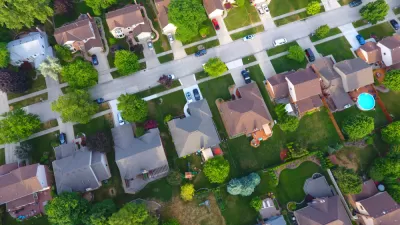This article from High Country News dissects the Arizona real estate collapse through the lens of one exurb.
"Surprise, Ariz., doesn't look very surprising. It might be anywhere in the suburban West. Home Depot and Wal-Mart rise like islands from an ocean of pavement, and late-model SUVs gleam in the midday sun. Homes with red-tiled roofs line up like stucco boxes on a giant supermarket shelf. There's little to distinguish this from the hundreds of square miles of housing developments that have sprouted around Las Vegas and San Diego. If it weren't for the palm trees, you could be in suburban Salt Lake City.
But only Surprise has the Radiant Church. Inside this 55,000-square-foot behemoth, 50-inch plasma-screen televisions display huge images of American flags. Starbucks-trained baristas serve up frothy espresso drinks, and the casually dressed congregation nibbles Krispy Kreme doughnuts. The pastor, Lee McFarland, wears jeans and rides a Harley. His uncanny ability to tap into the exurban zeitgeist made this the fastest-growing megachurch in one of the nation's fastest-growing metro areas.
Radiant symbolizes the breakneck growth and prosperity that have come to define Surprise and its Western siblings. Since it was incorporated in 1960, Surprise -- an exurb of Phoenix -- has burgeoned from 500 people to over 100,000 people spread over 100 square miles. Most of that growth happened in the last decade, and it happened largely independent of any economic base, such as manufacturing, mining, farming or even high-tech industry. Instead, growth created its own economic base. To the members of Radiant Church, it must have seemed like a miracle.
Now it seems more like a mirage."
Thanks to J.P. Thompson
FULL STORY: Surprise!

Depopulation Patterns Get Weird
A recent ranking of “declining” cities heavily features some of the most expensive cities in the country — including New York City and a half-dozen in the San Francisco Bay Area.

California Exodus: Population Drops Below 39 Million
Never mind the 40 million that demographers predicted the Golden State would reach by 2018. The state's population dipped below 39 million to 38.965 million last July, according to Census data released in March, the lowest since 2015.

Chicago to Turn High-Rise Offices into Housing
Four commercial buildings in the Chicago Loop have been approved for redevelopment into housing in a bid to revitalize the city’s downtown post-pandemic.

New Park Opens in the Santa Clarita Valley
The City of Santa Clarita just celebrated the grand opening of its 38th park, the 10.5-acre Skyline Ranch Park.

U.S. Supreme Court: California's Impact Fees May Violate Takings Clause
A California property owner took El Dorado County to state court after paying a traffic impact fee he felt was exorbitant. He lost in trial court, appellate court, and the California Supreme Court denied review. Then the U.S. Supreme Court acted.

How Urban Form Impacts Housing Affordability
The way we design cities affects housing costs differently than you might think.
City of Costa Mesa
Licking County
Barrett Planning Group LLC
HUD's Office of Policy Development and Research
Mpact Transit + Community
HUD's Office of Policy Development and Research
City of Universal City TX
ULI Northwest Arkansas
Town of Zionsville
Urban Design for Planners 1: Software Tools
This six-course series explores essential urban design concepts using open source software and equips planners with the tools they need to participate fully in the urban design process.
Planning for Universal Design
Learn the tools for implementing Universal Design in planning regulations.






















